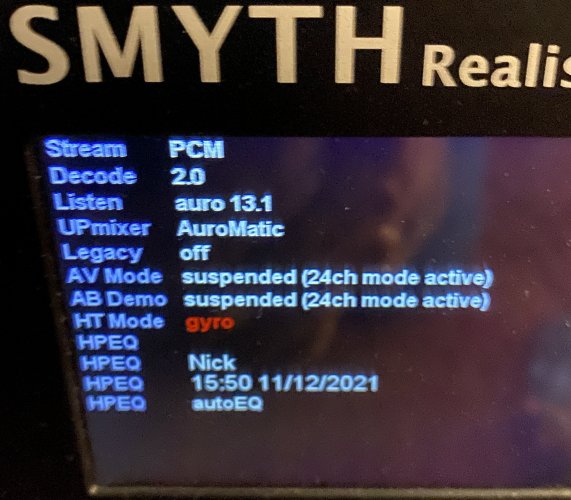So, let me get this straight. Let's say I'm playing the stereo mix of "A Day In the Life," coming from my PC, into my DAC, and then through my optical out of my DAC into the A16. My cans are plugged into the A16, and now, by using a pre-set PRIR file, the Beatles can be coming from 16 virtual speakers all around me, into my HD800s and into my ears, without any coloration from the A16?
If you had a 16-channel PRIR, measured in some room that had 16 real speakers, then the Realiser will reproduce the sound through 2-channel stereo headphones of that 16-speaker room when any multi-channel source audio program is fed to it, exactly as that same multi-channel source audio program would have sounded if played in the original room.
If you play the 2.0 stereo mix in that 16-speaker room which you created the 16-channel PRIR for, the 2.0 source program would normally only use 2.0 (or more likely 2.1) speakers of the 16 available speakers. None of the other 13 speakers would come into play. That's how it would have been heard had you been seated in the room represented by that 16-channel PRIR if you played 2.0 source, and that's how it will sound through the Realiser and headphones using that 16-channel PRIR to play 2.0 source. You will NOT hear the 2.0 program through all 16-channels of virtual speakers, same as you would NOT hear the 2.0 program through all other speakers in the 16-channel real room.
Now, if you had this in mind when you were in the listening environment creating your PRIR, and you wanted to create a separate second PRIR which reflected how that 16-channel room actually sounded if the "stadium DSP" effect was enabled through the electronics (i.e. non-16-channel source matrixed electronically into being output from all 16 speakers, including running the Realiser test sweep frequencies normally targeted for each individual speaker discretely one at a time but now through the same "stadium DSP" so as to produce sound intended for one speaker through all 16 speakers, same as your ears would hear it sitting there), then you could subsequently use that second PRIR for playback of 2.0 source and it would sound just like that room did when the "stadium DSP" effect was being used. Now you would hear the 2.0 source through all virtual 16 speakers, same as it would have sounded in the real room.
And to make the point again, the PRIR is created to capture how a particular listening room sounds to your ears and brain (not someone else's) when any given sound frequency is sent to any of the available real loudspeakers in that room. Whatever caused the sound of that room to be "heard and processed" by your own personal hearing system (ears, skull, brain, etc.) that's what the microphones in each of your ears are capturing. Speaker brand, size, location (relative to where you're seated), electronics, DSP-processing potential for "effects", floor/wall/ceiling treatments and baffles, etc., etc. Whatever causes the sound of that particular listening environment to be whatever it sounds like to you, that's what that PRIR reflects. It's not meant to describe any other room, nor how any other person would have heard the sound of that same room had they had their own custom PRIR also created.
That's why two people must each have their own custom PRIR measured for a single listening room, if you want to both "listen simultaneously as if in that same room" during playback of any source program. The Realiser will be using the two separate PRIR's independently to reproduce that same single room to each of two separate hearing systems as the two of you possess. A PRIR is not a "one size fits all" to describe a given listening environment (as, for example, the Dolby Headphone processing notion might be described as). It also includes YOUR HEARING SYSTEM in that description (just like prescription eyeglasses for YOUR EYES ALONE, but for your ears).

























